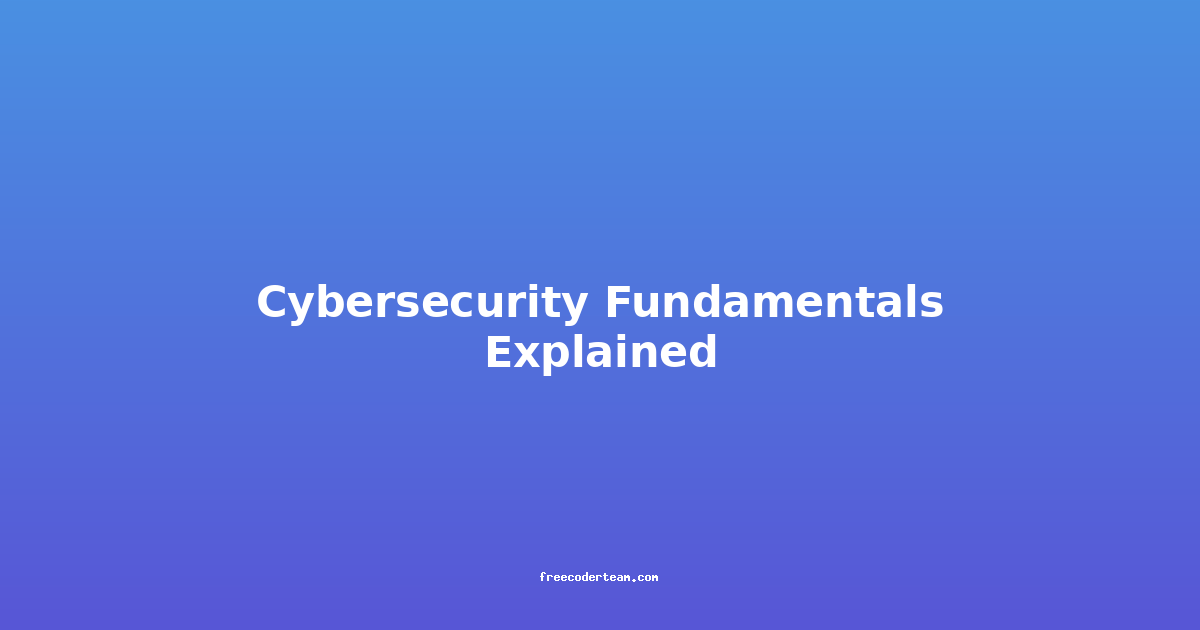Web Security Best Practices: From Scratch
In today's digital landscape, web security is paramount. Cyberattacks have become increasingly sophisticated, and even a single vulnerability can lead to devastating consequences, such as data breaches, financial loss, or damage to a company's reputation. Whether you're a developer, system administrator, or business owner, understanding web security best practices is essential to safeguard your applications and data.
In this comprehensive guide, we'll explore foundational web security principles, best practices, and actionable insights to help you build robust and secure web applications. We'll cover everything from secure coding practices to user authentication and beyond.
Table of Contents
- Understanding Web Security Threats
- Secure Coding Practices
- Secure Authentication and Authorization
- Using HTTPS and Secure Communication
- Protection Against Common Attacks
- Regular Updates and Patch Management
- Conclusion
Understanding Web Security Threats
Before diving into best practices, it's crucial to understand the common threats that web applications face. Being aware of these attack vectors helps you design defenses proactively.
Common Attack Vectors
- Injection Attacks: Attackers inject malicious code into input fields to manipulate databases or execute unauthorized actions. Examples include SQL injection and command injection.
- Cross-Site Scripting (XSS): Attackers inject malicious scripts into web pages to steal user data or hijack sessions.
- Cross-Site Request Forgery (CSRF): Attackers trick authenticated users into performing unintended actions on a website, such as transferring funds or changing settings.
- Broken Authentication: Weak authentication mechanisms allow attackers to compromise user accounts.
- Insecure Direct Object References (IDOR): Attackers exploit direct object references to access restricted resources.
- Security Misconfiguration: Default settings, unused pages, or exposed sensitive information can lead to vulnerabilities.
Secure Coding Practices
The foundation of web security lies in writing code that is secure from the ground up. Here are some best practices to ensure robust application security.
Input Validation and Sanitization
One of the most critical steps in securing web applications is validating and sanitizing user input. This prevents attackers from injecting malicious data into your application.
Example: Sanitizing User Input in PHP
<?php
// User input
$username = $_POST['username'];
// Basic sanitization: Remove any non-alphanumeric characters
$username = preg_replace('/[^a-zA-Z0-9]/', '', $username);
// Further validation: Ensure the username is within a valid length
if (strlen($username) < 3 || strlen($username) > 20) {
die("Username must be between 3 and 20 characters.");
}
// Store the sanitized username
$cleanUsername = $username;
?>
Best Practices:
- Use whitelisting to accept only allowed characters or patterns.
- Set maximum length limits for inputs.
- Validate data on both the client and server sides.
Output Encoding
When rendering user-generated content (e.g., comments, posts), it's essential to encode the output to prevent XSS attacks. This involves escaping special characters so they are treated as plain text by the browser.
Example: Escaping Output in JavaScript
// Example: Displaying user input safely
const userInput = document.getElementById('user-input').value;
const escapedOutput = escape(userInput); // Or use libraries like DOMPurify
document.getElementById('output').innerHTML = escapedOutput;
Best Practices:
- Use built-in encoding functions or libraries like DOMPurify for HTML output.
- Always encode data before rendering it in the browser.
Secure Authentication and Authorization
Authentication and authorization are critical components of web security. Poorly implemented mechanisms can lead to account compromises and unauthorized access.
Password Security
Storing passwords securely is non-negotiable. Always use bcrypt, Argon2, or similar password hashing algorithms instead of weak hashes like MD5 or SHA1.
Example: Password Hashing in Python
import bcrypt
# Hashing a password
password = b"securepassword123" # Password must be bytes
salt = bcrypt.gensalt()
hashed_password = bcrypt.hashpw(password, salt)
# Verifying a password
user_input = b"securepassword123"
if bcrypt.checkpw(user_input, hashed_password):
print("Password is correct.")
else:
print("Password is incorrect.")
Best Practices:
- Use strong, unique salts for each password.
- Never store passwords in plain text.
- Enforce strong password policies (e.g., minimum length, complexity).
Session Management
Session management involves securely handling user sessions to prevent session hijacking or fixation.
Example: Secure Session Handling in Node.js
const express = require('express');
const session = require('express-session');
const app = express();
app.use(session({
secret: 'your-secret-key',
resave: false,
saveUninitialized: false,
cookie: {
secure: true, // Only send cookie over HTTPS
httpOnly: true, // Prevents JavaScript access to the cookie
sameSite: 'strict' // Prevents CSRF by restricting cross-site access
}
}));
app.get('/login', (req, res) => {
req.session.isAuthenticated = true;
res.send('You are logged in!');
});
app.get('/protected', (req, res) => {
if (req.session.isAuthenticated) {
res.send('This is a protected page.');
} else {
res.send('You are not authenticated.');
}
});
app.listen(3000, () => {
console.log('Server running on port 3000');
});
Best Practices:
- Use secure cookies (
secure,httpOnly,sameSiteflags). - Regenerate session IDs after authentication.
- Implement session timeouts and inactivity limits.
Using HTTPS and Secure Communication
HTTPS is the standard for secure communication over the web. It encrypts data between the client and server, preventing eavesdropping and tampering.
Example: Configuring HTTPS in Nginx
server {
listen 443 ssl;
server_name yourdomain.com;
ssl_certificate /path/to/certificate.pem;
ssl_certificate_key /path/to/privatekey.pem;
ssl_protocols TLSv1.2 TLSv1.3;
ssl_ciphers 'ECDHE-ECDSA-AES128-GCM-SHA256:ECDHE-RSA-AES128-GCM-SHA256:ECDHE-ECDSA-AES256-GCM-SHA384:ECDHE-RSA-AES256-GCM-SHA384:ECDHE-ECDSA-CHACHA20-POLY1305:ECDHE-RSA-CHACHA20-POLY1305:DHE-RSA-AES128-GCM-SHA256:DHE-RSA-AES256-GCM-SHA384';
ssl_prefer_server_ciphers on;
location / {
proxy_pass http://localhost:8080;
}
}
Best Practices:
- Use strong TLS protocols (e.g., TLS 1.2 or 1.3).
- Regularly renew SSL/TLS certificates.
- Implement HSTS (HTTP Strict Transport Security) to force secure connections.
Protection Against Common Attacks
Cross-Site Scripting (XSS)
XSS occurs when malicious scripts are injected into web pages. To prevent XSS, always encode output and use content security policies (CSP).
Example: Content Security Policy in HTML
<meta http-equiv="Content-Security-Policy" content="default-src 'self'; script-src 'self'; style-src 'self';">
Best Practices:
- Use output encoding libraries (e.g.,
DOMPurifyfor JavaScript). - Implement CSP to restrict script execution.
- Disable unnecessary HTML tags and attributes.
SQL Injection
SQL injection occurs when attackers inject malicious SQL queries into input fields. To prevent SQL injection, use prepared statements or parameterized queries.
Example: SQL Injection Prevention in Python (SQLAlchemy)
from sqlalchemy import create_engine, text
engine = create_engine('sqlite:///example.db')
# Unsafe query
# query = text("SELECT * FROM users WHERE username = '" + username + "'")
# Safe query using parameterized statements
query = text("SELECT * FROM users WHERE username = :username")
result = engine.execute(query, username=username).fetchall()
Best Practices:
- Use prepared statements or ORM libraries.
- Never concatenate user input into SQL queries.
Cross-Site Request Forgery (CSRF)
CSRF occurs when attackers trick authenticated users into performing actions they didn't intend. Use CSRF tokens to verify requests.
Example: CSRF Protection in Django
from django.views.decorators.csrf import csrf_exempt, csrf_protect
@csrf_protect
def sensitive_action(request):
if request.method == 'POST':
# Process the request
pass
return HttpResponse("Action processed.")
@csrf_exempt
def public_view(request):
# This view does not require CSRF protection
pass
Best Practices:
- Use CSRF tokens or double submit cookies.
- Implement the
SameSitecookie attribute to mitigate CSRF.
Regular Updates and Patch Management
Keeping your software up to date is crucial for defending against vulnerabilities. Regularly update:
- Web frameworks (e.g., Django, Express.js)
- Libraries and dependencies
- Operating systems and server software
Example: Checking for Dependencies Updates in Python
pip list --outdated
Best Practices:
- Use dependency managers with automatic update notifications.
- Regularly review and update third-party libraries.
- Monitor security advisories for critical vulnerabilities.
Conclusion
Web security is a complex but essential aspect of modern web development. By following best practices like secure coding, robust authentication, and protection against common attacks, you can significantly reduce the risk of vulnerabilities.
Remember, security is an ongoing process. Stay informed about the latest threats and best practices, and regularly audit your applications for potential vulnerabilities. By prioritizing security from the start, you can build web applications that are resilient and trustworthy.
By implementing these best practices, you'll be well on your way to creating secure and reliable web applications that protect both your users and your business. Stay secure, stay vigilant! 🚀🔒
Disclaimer: This guide provides foundational information. For enterprise-level security, consult security professionals and follow industry-specific regulations.




